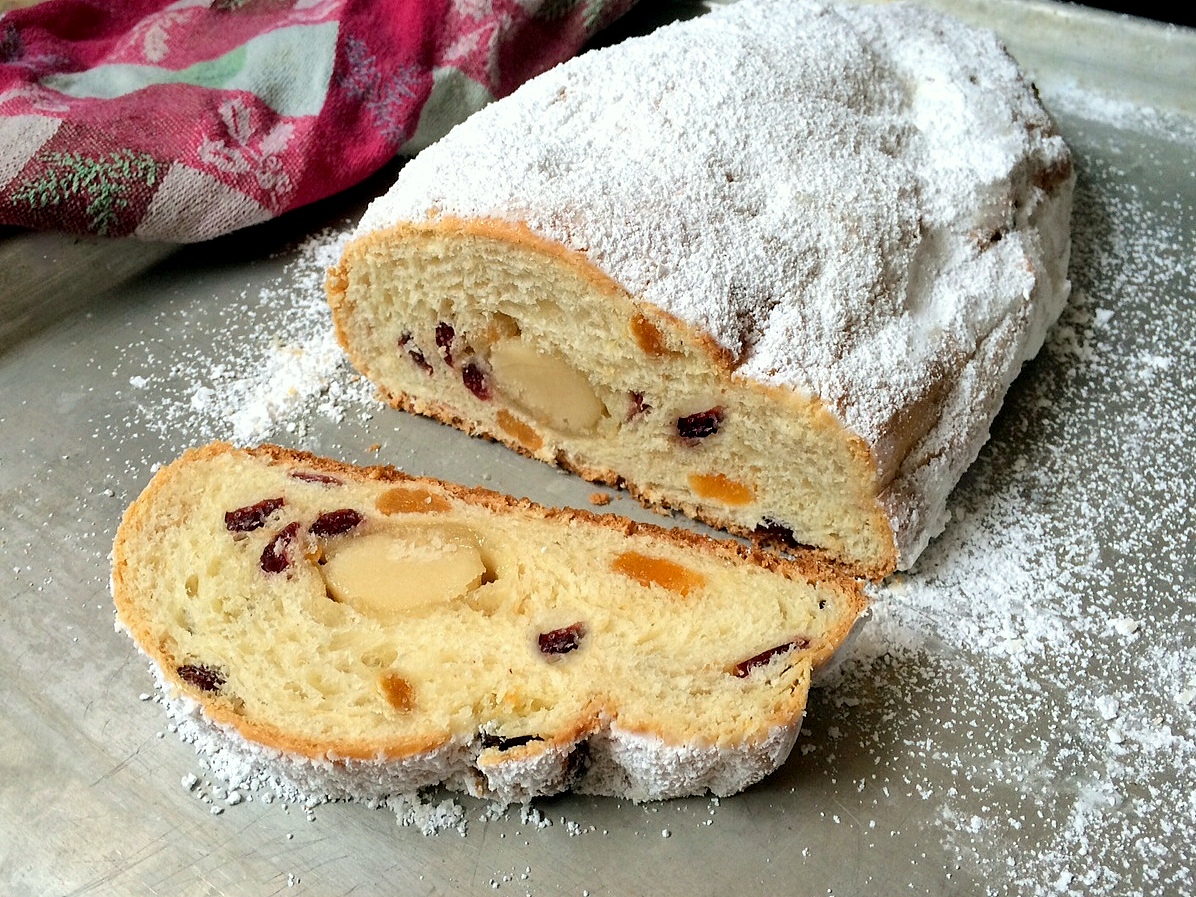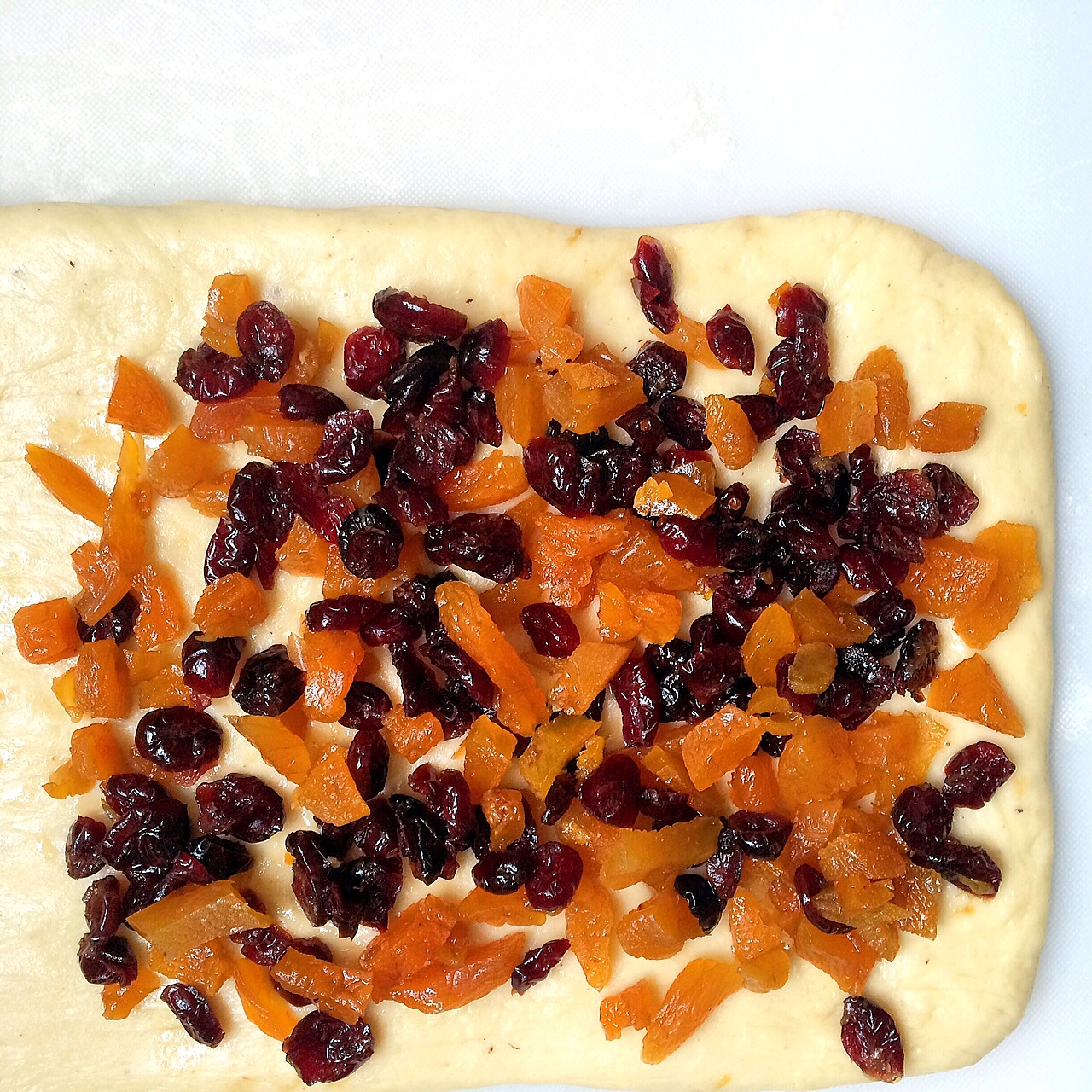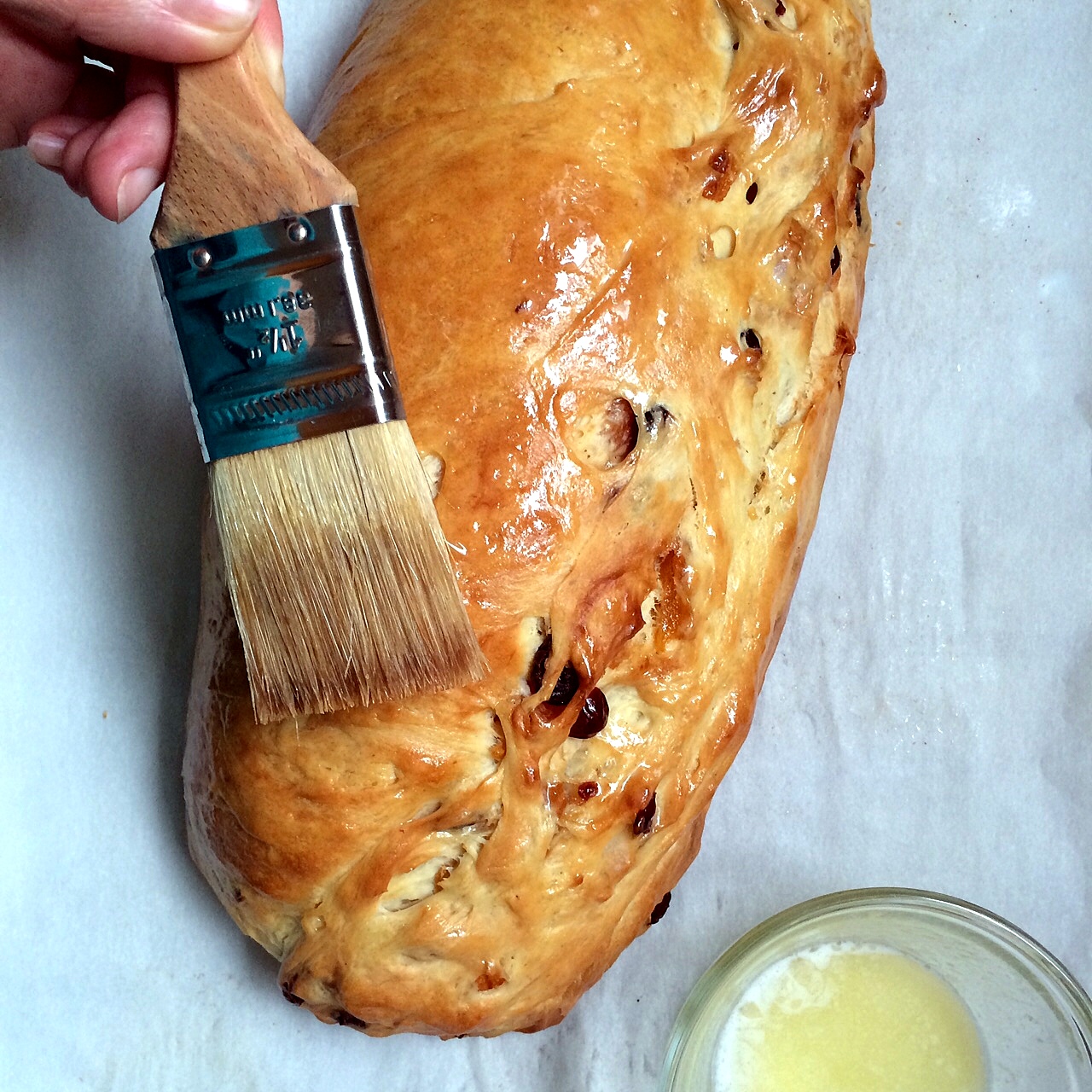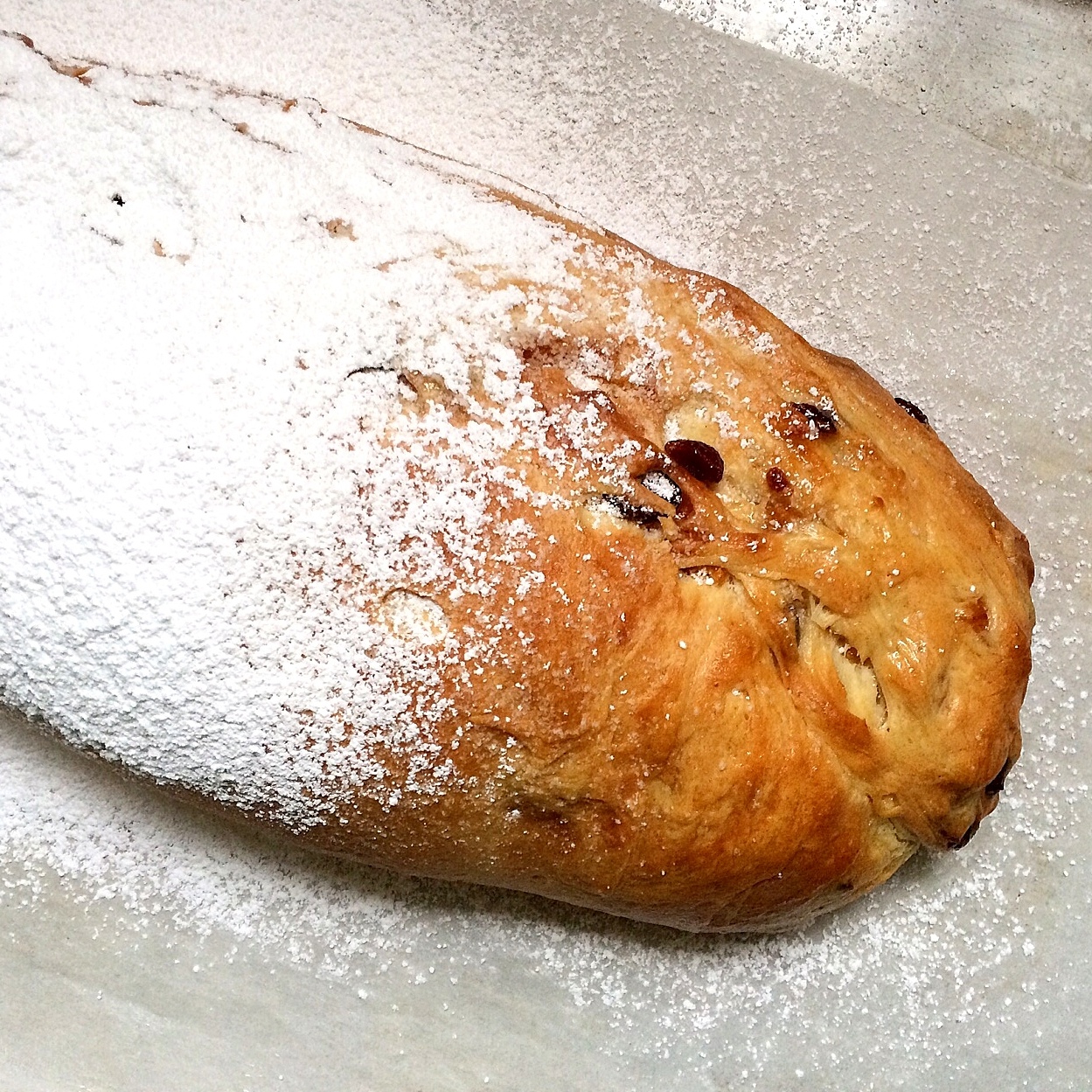Cranberry and Apricot Stollen
 I'm going Hyper-Christmas™ this year, people. I'm talking going to cookie exchanges, lots of baking and candymaking, cranking up the Bublé (is it just me, or is he the new Bing Crosby?), and making my kids wear matching Christmas jammies because I'm their mother and I only have a few good years to get away with such frippery. Fa-la-la-la-la!!
I'm going Hyper-Christmas™ this year, people. I'm talking going to cookie exchanges, lots of baking and candymaking, cranking up the Bublé (is it just me, or is he the new Bing Crosby?), and making my kids wear matching Christmas jammies because I'm their mother and I only have a few good years to get away with such frippery. Fa-la-la-la-la!!
I'm pretty pumped about the whole thing, and now that my girl is getting old enough to really get into baking with me all the way through a recipe and not peacing out right after dumping everything into the mixing bowl, I've been thinking about seasonal things we can make together every year, and start a new little tradition of our own. Of course, every holiday season officially kicks off with a batch of my very favorite sugar cookies, but this year I came across a cozy recipe that absolutely screams Christmas--sweet, colorful, a bit of history from my German heritage involved, and just enough of a process to make it holiday-worthy and not something you'd do on any old weekend. Lately I've been so inspired by all the amazing German baked goods Luisa has been sharing on Instagram as she writes her next sure-to-be-fabulous book, and now I'm all, GUTEN TAG, LET'S MAKE ALL THE KUCHEN, BITTE. It's pure magic, the things she's been turning out.

Enter the stollen. We're all in with this festive, flavorful loaf, decked out with a winter-appropriate, snowy layer of confectioner's sugar. It's bit like a denser, slightly drier Brioche (a lot more delicious than it sounds by that mediocre description), studded with bits of dried fruit, encasing a tunnel of sugary marzipan, which puts the whole thing over the top. The recipe comes from my favorite new cookbook, Jane Hornby's What to Bake and How to Bake It. The book's step-by-step photos came in especially handy for a recipe like stollen, where there's a particular magic to folding the dough in order to incorporate the fruit without making the dough look messy and weird. The recipes in the book are so all-purpose and straightforward, it's the ultimate baker's arsenal, in book form. I just can't stop paging through it, and have already gifted it. Love.

As for the stollen itself, it's perfection with coffee (or lots of milk, as the baby kept demanding slice after slice), and is the kind of thing that transports you to other Christmas-y worlds, magical European places that look like snow globe villages and children have adorable haircuts and rosy cheeks and happily play with quiet wooden toys. It's enough to temporarily make you forget that your own American children won't sit still long enough for a decent haircut unless plied with lollipops, and would rather play with things made of plastic that play crazy loud music and watch Frozen for the 500th time. Sigh. At least they liked the stollen.
Happy holidays, darling readers--I'll see you in 2015!

Cranberry and Apricot Stollen Adapted from Jane Hornby's What to Bake and How to Bake It
I halved this recipe to make one large loaf, which was plenty for our family of four, but soon wished I'd made the whole dang recipe because it stores so well and would've made a great gift for a lucky friend. So I guess I'll just need to make another full batch--OH WELL.
I recommend using a ruler to guide you in patting out the dough and shaping the loaves so the size between the two is consistent. The other thing I discovered is that it's key to making sure the dough is kneaded very well, at least a full 10 minutes by hand, to make sure that the fruit won't make the dough all mushy. Here's a great list of tips and helpful comments to know when you've kneaded long enough.
Makes 2 family-sized loaves
For the bread:
1 cup (4 ounces/113 grams) dried cranberries 1 cup (4 ounces/113 grams) chopped dried apricots ¼ cup (2 ounces/57 grams) dark rum (I like Myers' rum; you could also swap in orange juice here) 1 tablespoon finely grated lemon zest 1 teaspoon pure vanilla extract 1 1/4 cups (10 ounces/284 grams) whole milk 1 tablespoon instant dry yeast 4 cups (17 5/8 ounces/500 grams) bread flour, plus extra for kneading 1/3 cup (2 5/8 ounces/67 grams) granulated sugar 2 teaspoons freshly grated nutmeg 1 teaspoon fine sea salt 12 tablespoons (6 ounces/170 grams) unsalted butter, cut into small pieces 1 large egg 1 large egg yolk 9 ounces (255 grams) marzipan
To finish:
4 tablespoons (2 ounces/57 grams) unsalted butter, melted 1/4 cup (1 ounce/28 grams) confectioners’ sugar
In a medium bowl, mix together the dried fruit, rum (or orange juice), lemon zest, and vanilla extract. Let macerate while you make the dough. Gently warm the milk in the microwave or in a saucepan on the stove, then whisk in the yeast. The milk must only be warm to the touch; if it’s too hot, it will kill the yeast.
In a large bowl, whisk together the flour, sugar, nutmeg, and salt. Using your fingertips, rub the butter into the flour mixture until the mixture looks like breadcrumbs.
Add the whole egg and yolk to the milk and whisk well. Using a wooden spoon, mix the liquid into the rubbed-in mixture to make a soft, sticky dough. Let stand for 10 minutes.
Dust the work surface with flour, then turn the dough out onto it. Flour the top of the dough and your hands, then begin to knead. Keep going for about 10 minutes, until the dough feels very springy or elastic and silky smooth. Use more flour if you need to. Put the dough in an oiled bowl and cover with oiled plastic wrap. Let rise in a warm place until doubled in size, about 1 1/2 hours.
Turn the dough out onto the floured work surface and cut it in half. Use your hands to press and pat each half into a rectangle about 8 x 15 inches. Spread the soaked fruit over the bottom half of each rectangle, then fold the top half over it.
Pat the dough out to about 6 x 10 inches, then fold it in half again along the long edge; repeat this twice, or until the fruit is well distributed in the dough, but isn’t escaping. You should end up with 2 rectangles about 6 x 10 inches. (If at any point it starts being too springy to handle, let it sit for a few minutes, then continue.)
Roll the marzipan into 2 thin logs, about the same length as the rectangles. Using the side of your hand from the tip of you pinky to you wrist, press a deep groove along the length of each piece of dough, then place the marzipan in it.
Roll the left side of the dough over the marzipan. Press and pinch the edges together well to make a lip of dough. Fold the very ends of the loaves under to completely enclose the marzipan, and shape the ends into slight points.
Line a large baking sheet with parchment paper and lift the breads onto it. Leave room for rising. Cover with oiled plastic wrap and let proof in a warm place for 1 hour, or until almost doubled in size. Preheat the oven to 350°F.
Bake for 30 minutes, or until the breads have risen well and are dark golden brown. Let cool for about five minutes. Flip the breads over and brush the bottoms with melted butter, and generously sift confectioners’ sugar to coat. Turn the breads right side up again and repeat the butter bathing and sugar coating. Let the loaves cool completely before wrapping and storing. Dust any bare spots with sugar again before slicing and serving.